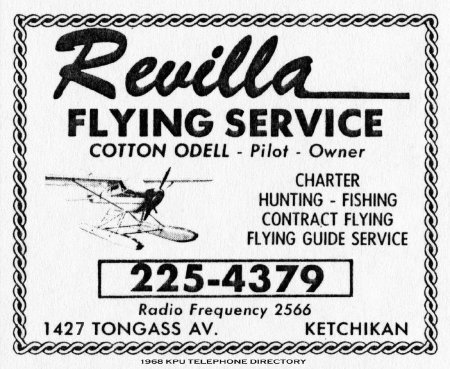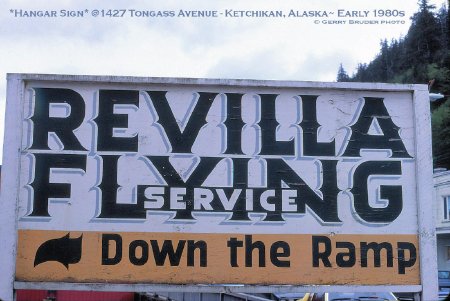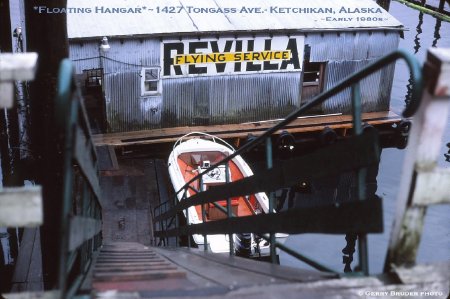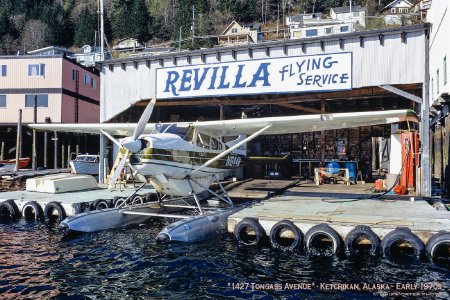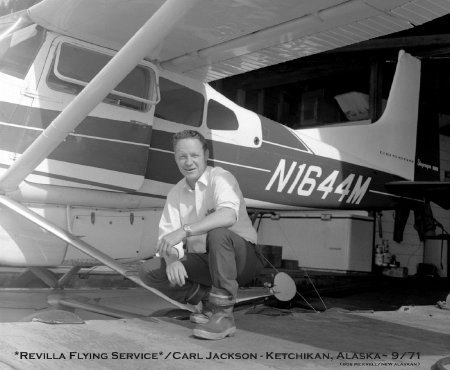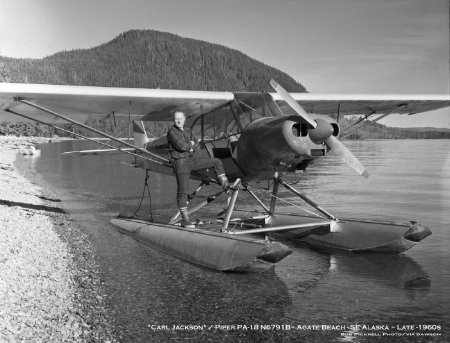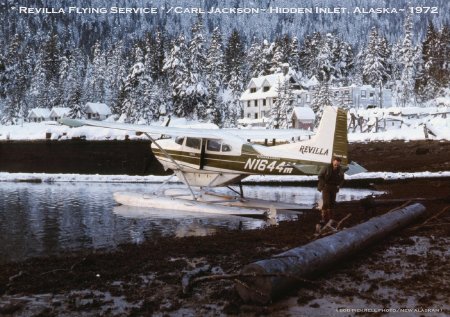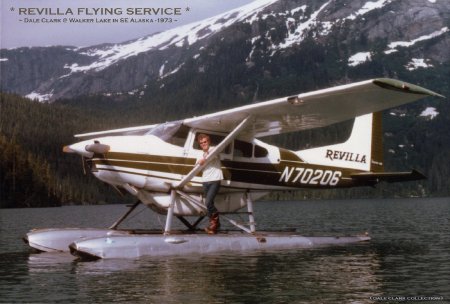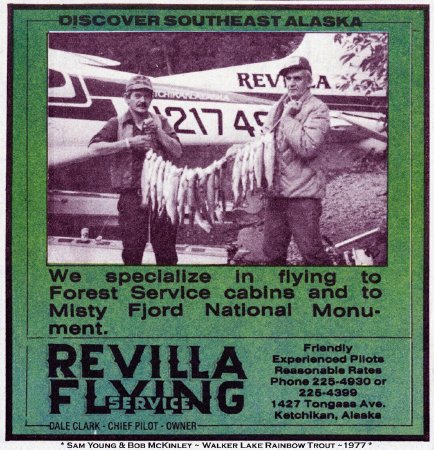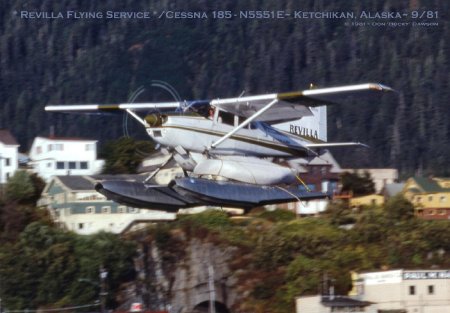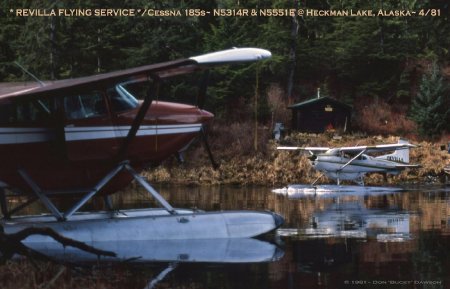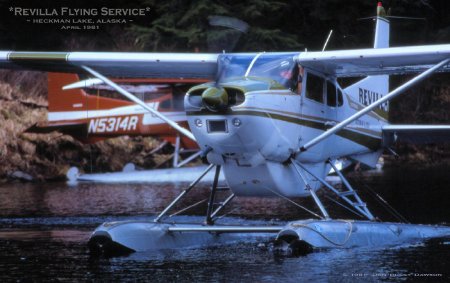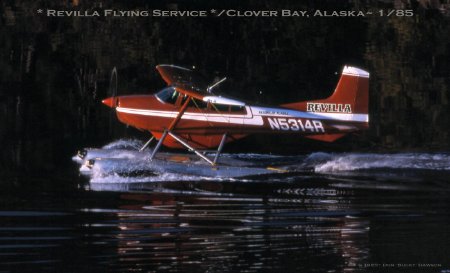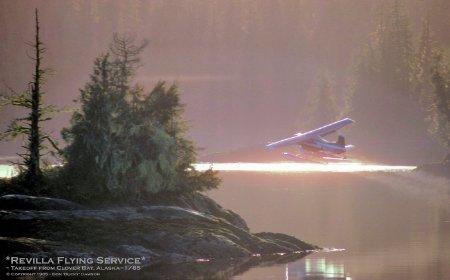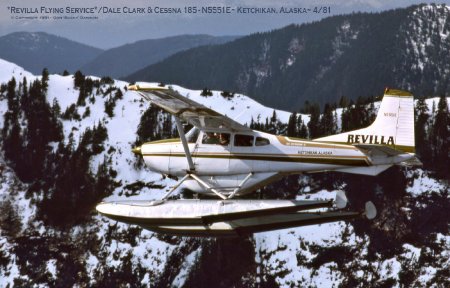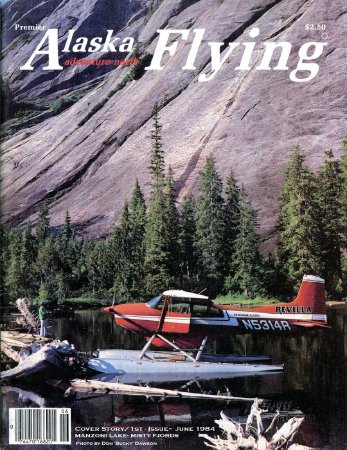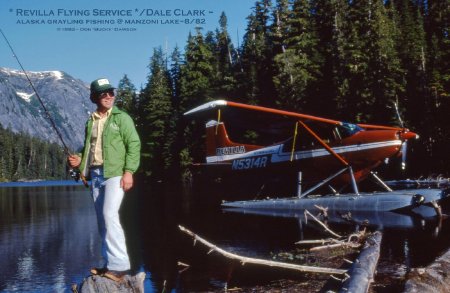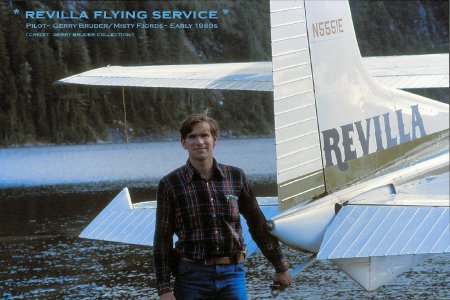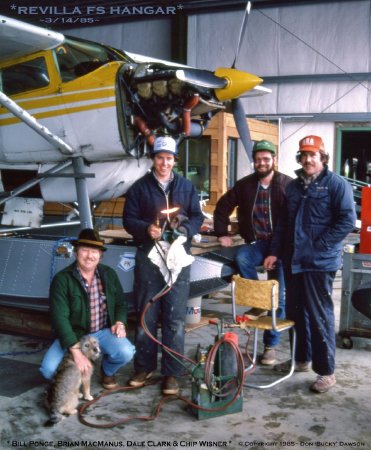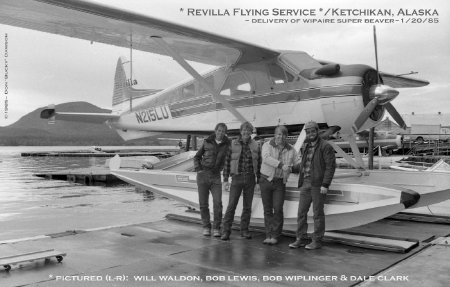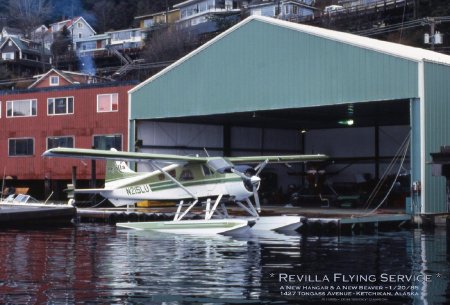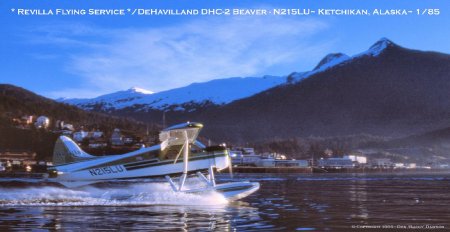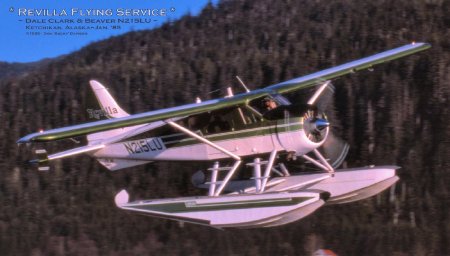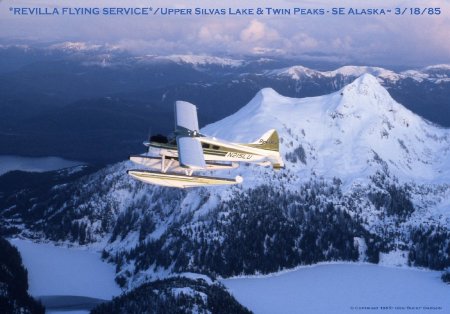Description:
Revilla Flying Service, 1966-1986
Revilla Flying Service was founded by pilot Cotton Odell (T. M. Odell) in 1966, flying a single Cessna 185 Skywagon seaplane. The company name used the abbreviated version of Revillagigedo Island, where Ketchikan is located. Cotton's floating hangar/office was located at 1427 Tongass Avenue, right next door to the large Ellis Air Lines Goose Maintenance Hangar, and adjacent to Webber Air Service. Cotton briefly flew for Ed Todd before starting his own outfit. He eventually hired Carl "Red" Jackson to be his second pilot around March or April 1971. Jackson had just opted out of his three-way partnership with Don Ross and Earl Lahmeyer in Ketchikan Air Service, which they had acquired in the Summer of 1970. Jackson purchased his own Cessna 185 (N1644M) and bought Revilla Flying Service from Cotton Odell in February 1972.
Carl Jackson first arrived Ketchikan from Montana in April 1958 and initially worked in construction. He purchased and operated the Focsle Bar for 3 to 4 years. He then decided to learn how to fly and got his commercial pilot license. Becoming a one-third owner and pilot in Ketchikan Air Service with Ross and Lahmeyer for a year and a half, Jackson got his mind set on wanting to start his own charter flying enterprise. Going to work for Cotton Odell was the key to realizing his ambitions. Red Jackson was an avid sportsman and guide, and he loved catering to wilderness fishing and hunting charters. At one time, he was partner with Terry Wills and others in the Misty Fjords Resort Chalet at Humpback Lake, built around 1969-1970. In June 1972, Jackson's brother-in-law- Dale Clark moved to Ketchikan from Montana to work helping out at Revilla Flying Service. Clark got his floatplane rating and then commercial license, and began flying for the company later that year.
In the Spring of 1973, Carl Jackson bought a new Cessna 185 (N70295) through a Duluth Minnesota dealership and traveled back east to accept delivery of the airplane in Long Island, New York accompanied by his local borough assemblyman friend Bob Crowder. He flew the plane to Duluth for radio upgrades and seat reconfigurations, before flying to Montana to visit his parents. A blizzard there extended their ferry flight trip back to Ketchikan, taking a month to make it back home. That summer, Carl Jackson was flying his new plane when tragedy struck. On August 4, 1973, a fatal airplane accident occurred on Annette Island that claimed his life and four passengers, with one survivor. Ownership of Revilla was then assumed by Jackson's widow Frances C. Jackson Young. Her brother Dale Clark took over as the primary company pilot. On February 22, 1979, an application was filed with Alaska Transportation Commission to buy the Revilla Flying Service certificate, and Dale Clark subsequently purchased the company to become its new owner. Carl's son Brian Jackson also served with Dale on the pilot roster. Running two Cessna 185s became Revilla Flying Service's standard plane complement in handling their air charter work demand. A few other Ketchikan pilots filled in when needed, and eventually Gerry Bruder signed on as Revilla Flying Service's regular second pilot. Besides running the standard air taxi commuter and freight operations, Dale Clark maintained focus on keeping the company popular for specializing on wilderness fly-in hunting and fishing charters to the best remote spots around the area, having learned the skillsets from Jackson and the local experts. From day one, a major part of Revilla's business bread and butter was flying passengers to and from Metlakatla.
The rapidly growing popularity of Southeast Alaska's tourism allowed commercial seaplane aviation competition to thrive. Smaller independent single and two plane Part 91 and Part 135 outfits did especially well, as long as they worked within their means and avoided the ever present temptation of "going bigger" to try gaining more profits. The original Revilla Flying Service hangar was becoming dilapidated. In 1984, Dale Clark designed and built a new larger more modern hangar and float. The design incorporated a powerful electric folding main door that served as the building's waterfront seaplane ramp while open, along with an electric aircraft hoist. Clark did most of the work himself, and hired Bill Schoocraft from Metlakatla to help build the hangar's cement floats out at Seaward Ship Yard at Mud Bight. On January 20, 1985, Revilla Flying Service purchased a reconditioned Wipaire DHC-2 Super Beaver (N215LU) mounted on a set of Wipaire seaplane floats and sporting a beautiful custom paint scheme, to put to work alongside the company's faithful Cessna 185 Skywagon aircraft.
Many folks were then quite surprised in 1986, when Dale Clark suddenly decided to close down the business just a few years after he made all the revamping investments. He then flew for Temsco Airlines, Taquan Air, Promech Air, and then Taquan Air again to wrap up his lengthy career. Dale Clark retired as commercial pilot on September 16, 2014 with 30,000-plus total flying hours logged.
Aircraft:
Cessna 185 Skywagon and DeHavilland DHC-2 Beaver.
Pilots:
Cotton O'Dell, Carl Jackson, Dale Clark, Brian Jackson, Gerry Bruder, Dan Hassell, Royle Snodderly, and Steve Shrum, among others.
Mechanics:
Vern Schmutzler, Foster Goodrich, Alan Jones, and Brian MacManus.
Carl Jackson first arrived Ketchikan from Montana in April 1958 and initially worked in construction. He purchased and operated the Focsle Bar for 3 to 4 years. He then decided to learn how to fly and got his commercial pilot license. Becoming a one-third owner and pilot in Ketchikan Air Service with Ross and Lahmeyer for a year and a half, Jackson got his mind set on wanting to start his own charter flying enterprise. Going to work for Cotton Odell was the key to realizing his ambitions. Red Jackson was an avid sportsman and guide, and he loved catering to wilderness fishing and hunting charters. At one time, he was partner with Terry Wills and others in the Misty Fjords Resort Chalet at Humpback Lake, built around 1969-1970. In June 1972, Jackson's brother-in-law- Dale Clark moved to Ketchikan from Montana to work helping out at Revilla Flying Service. Clark got his floatplane rating and then commercial license, and began flying for the company later that year.
In the Spring of 1973, Carl Jackson bought a new Cessna 185 (N70295) through a Duluth Minnesota dealership and traveled back east to accept delivery of the airplane in Long Island, New York accompanied by his local borough assemblyman friend Bob Crowder. He flew the plane to Duluth for radio upgrades and seat reconfigurations, before flying to Montana to visit his parents. A blizzard there extended their ferry flight trip back to Ketchikan, taking a month to make it back home. That summer, Carl Jackson was flying his new plane when tragedy struck. On August 4, 1973, a fatal airplane accident occurred on Annette Island that claimed his life and four passengers, with one survivor. Ownership of Revilla was then assumed by Jackson's widow Frances C. Jackson Young. Her brother Dale Clark took over as the primary company pilot. On February 22, 1979, an application was filed with Alaska Transportation Commission to buy the Revilla Flying Service certificate, and Dale Clark subsequently purchased the company to become its new owner. Carl's son Brian Jackson also served with Dale on the pilot roster. Running two Cessna 185s became Revilla Flying Service's standard plane complement in handling their air charter work demand. A few other Ketchikan pilots filled in when needed, and eventually Gerry Bruder signed on as Revilla Flying Service's regular second pilot. Besides running the standard air taxi commuter and freight operations, Dale Clark maintained focus on keeping the company popular for specializing on wilderness fly-in hunting and fishing charters to the best remote spots around the area, having learned the skillsets from Jackson and the local experts. From day one, a major part of Revilla's business bread and butter was flying passengers to and from Metlakatla.
The rapidly growing popularity of Southeast Alaska's tourism allowed commercial seaplane aviation competition to thrive. Smaller independent single and two plane Part 91 and Part 135 outfits did especially well, as long as they worked within their means and avoided the ever present temptation of "going bigger" to try gaining more profits. The original Revilla Flying Service hangar was becoming dilapidated. In 1984, Dale Clark designed and built a new larger more modern hangar and float. The design incorporated a powerful electric folding main door that served as the building's waterfront seaplane ramp while open, along with an electric aircraft hoist. Clark did most of the work himself, and hired Bill Schoocraft from Metlakatla to help build the hangar's cement floats out at Seaward Ship Yard at Mud Bight. On January 20, 1985, Revilla Flying Service purchased a reconditioned Wipaire DHC-2 Super Beaver (N215LU) mounted on a set of Wipaire seaplane floats and sporting a beautiful custom paint scheme, to put to work alongside the company's faithful Cessna 185 Skywagon aircraft.
Many folks were then quite surprised in 1986, when Dale Clark suddenly decided to close down the business just a few years after he made all the revamping investments. He then flew for Temsco Airlines, Taquan Air, Promech Air, and then Taquan Air again to wrap up his lengthy career. Dale Clark retired as commercial pilot on September 16, 2014 with 30,000-plus total flying hours logged.
Aircraft:
Cessna 185 Skywagon and DeHavilland DHC-2 Beaver.
Pilots:
Cotton O'Dell, Carl Jackson, Dale Clark, Brian Jackson, Gerry Bruder, Dan Hassell, Royle Snodderly, and Steve Shrum, among others.
Mechanics:
Vern Schmutzler, Foster Goodrich, Alan Jones, and Brian MacManus.
Click to Enlarge

